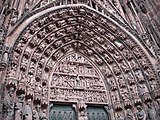Parataxe (visual arts)
The stringing together of similar elements is called parataxe in the fine arts .

architecture
In architecture, the same structural elements that are evenly arranged next to one another along a common base line are referred to as paratactic.
- Equality. The structural members have the same size and structure.
- Example: The windows and yokes of Villa Farnesina are congruent with each other.
- Uniformity. The components are equidistant from one another or directly connected to one another.
- Examples: The facade windows of Villa Farnesina are arranged at equal distances from one another. The apses of the Church of Santo Spirito are directly connected to each other by a common support.
- Common baseline.
- Examples: In the Villa Farnesina, the sill cornice forms the common base line of the windows and the base cornice forms the base line of the yokes. The figures in the tympanum walls of the Strasbourg cathedral are arranged along a curved line (pointed arch).
Paratactic vestibule as an external wall replacement (bold line). Filippo Brunelleschi : Floor plan of the Church of Santo Spirito in Florence.
Paratactically arranged figures in the garment of the tympanum . Strasbourg Cathedral, main portal.
Paratactic axis order. Seven axes with arched portals and rectangular windows between colossal columns and biforic windows on the second floor. Cesare Cesariano : Reconstruction of the basilica of Fano according to Vitruvius , elevation.
Painting and sculpture
In the case of paintings, drawings, graphics and reliefs, similar elements are called paratactic if they meet one of the two following requirements:
- The elements are arranged evenly next to one another along a common baseline.
- Examples: On some Egyptian seal amulets several figures (pharaoh and gods) stand next to one another without any recognizable interaction. In the still life with vessels of Francisco de Zurbarán four vessels are incoherent lined up in a line next to each other.
- The elements are randomly distributed on a surface, often close together, but not connected to one another.
- Example: In Hieronymus Bosch's painting The Garden of Earthly Delights , the scenic groups of figures are distributed over the entire surface of the picture. Most groups form a unit of their own with no relation to other groups.
Paratactic arrangement of vessels. Francisco de Zurbarán : Still life with vessels.
Paratactic arrangement of figures on a hidden object . Hieronymus Bosch : The Garden of Earthly Delights (central panel).
Paratactic sequence of scenes of the loosely lined up "Age of Love". Pencil drawing by Leonardo Camia based on Bertel Thorvaldsen's bas-relief Allegory of Ages .
Translations
The sign 'in front of a syllable means that the syllable is stressed.
| language | Word forms | |
| German | the Para'tax | para'tactical |
| English | para'taxis | para'tactic |
| French | la para'taxe | paratac'tique |
| Italian | la para'tassi | para'tattico |
| Spanish | la para'taxis | para'táctico |
Word origin
The word paratax is derived from ancient Greek παράταξις (parátaxis) "line up in rank and file" from παρά (pará) "next to" and τάξις (táxis) "order". The originally military term denotes in a figurative sense the arrangement of similar elements next to or next to one another.
literature
In general dictionaries, lexicons and encyclopedias and in art reference works, the terms parataxe and paratactic are not taken into account as a technical term in the fine arts.
- Paratactic arrangement: Accumulatio . In: Stefan Fischer: Hieronymus Bosch: Painting as a vision, teaching image and work of art , Cologne 2009, pages 187–192 ( online in the Google book search)
- Ulrich Fürst: School of Seeing - New Media in Art History: Introduction to Renaissance and Baroque Architecture , online without location and year: Lesson I, Chapter 2 ; Lesson I, Chapter 3 ; Lesson VIII, Chapter 4 ; Lesson XI, Chapter 1 .
- Ralf Grüßinger: Decorative architectural friezes in Rome and Latium. Iconological studies on Roman architectural decoration of the late republic and imperial times , Heidelberg 2001, passim ( online at the Ruprecht-Karls-Universität Heidelberg )
- Facades with paratactic rows of windows . In: Elisabeth Heil: Windows as a design element on palace facades of the Italian early and high renaissance , Hildesheim 199, pages 451–481.
- Henry George Liddell ; Robert Scott : A Greek-English Lexicon, revised and augmented throughout by Sir Henry Stuart Jones , with the assistance of Roderick McKenzie , Oxford 1940, keyword παράταξις ( online at Tufts University )
- Peter Lodermeyer: Transformations of Still Life in Post-Cubist Painting by Pablo Picasso , Münster 1998, page 194 ( online in the Google book search)
- Cesare Cesariano (1521): The public or "paratactic-open colossal facade" . In: Monika Melters: The colossal order: on palace construction in Italy and France between 1420 and 1670 , Berlin 2008, pages 81–84.
- Andrea Palladio (1570): The frontespicio as a pseudoporticus and the private or "paratactic-closed colossal facade " of the city palace. In: Monika Melters: The colossal order: on palace construction in Italy and France between 1420 and 1670 , Berlin 2008, page 93-97.
- André Wiese: On the image of the king on Egyptian seal amulets , Freiburg 1990, page 108, fig. 131-138 ( online in the Google book search)
- Claudia Wölfel: Myth and political allegory on silverware from the Roman Empire , Berlin 1996, page 137, 139 ( online at Freie Universität Berlin )
Individual evidence
- ↑ Prince 2012 ; Grüßinger 2001 ; Heil 1995 ; Melters 2008.1 ; Melters 2008.2 .
- ↑ Facade fields between two pilasters.
- ↑ Grüßinger 2001 , pages 4–5; Lodermeyer 1998 ; Wiese 1990 ; Wölfel 1996 .
- ↑ Fischer 2009 .
- ↑ Liddell 1940 .
- ↑ To find the references in the PDF file, search for “paratactic”.





